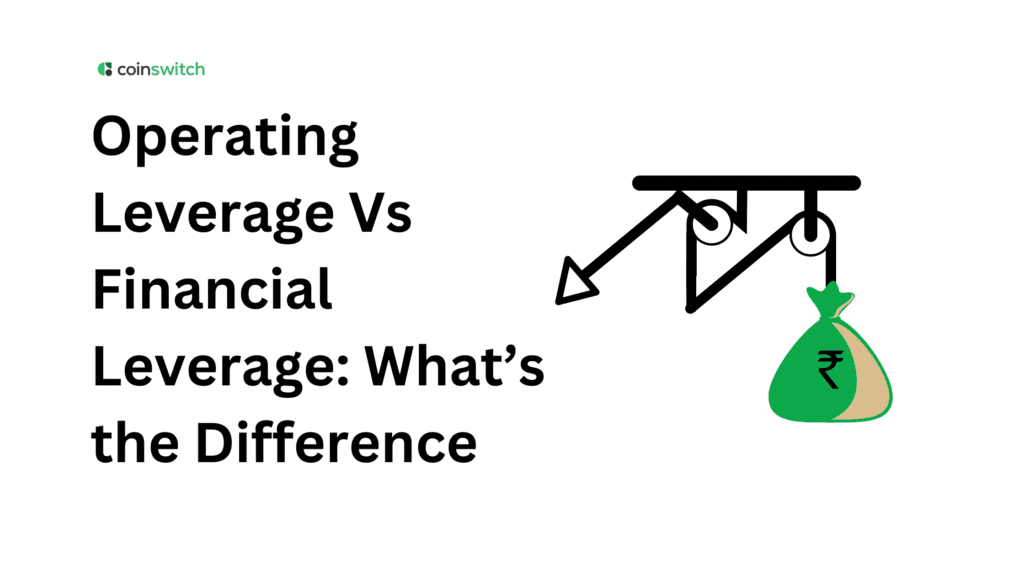Making wise judgments in the commercial and financial world requires an awareness of leverage. The deployment of resources or tactics to increase possible outcomes—whether favorable or unfavorable—is often referred to as leverage. Companies must carefully manage both operating and financial leverage to reap the benefits of this expansion.
Financial leverage involves using borrowed money, whereas operating leverage relates to the use of fixed expenses in operations. Investors, managers, and people may evaluate risks and returns more skillfully if they understand the differences between these two types of leverage. Let’s take a closer look at these ideas.
What is Financial Leverage
Financial leverage involves using debt or borrowed money to increase the potential return on investment. In essence, a business that employs financial leverage borrows money in the hope that the profits it makes from its activities will outweigh the cost of the loan. The difference between profits and interest payments on borrowed money can greatly impact profitability.
By taking on debt, a company can grow, engage in new ventures, or acquire assets without having to issue additional shares, thereby diluting ownership. Because the business generates more revenue than it spends on interest, this tactic can increase earnings during prosperous times. However, financial leverage involves risks. The business may face financial difficulties if its earnings are insufficient to cover interest costs.
Industries with significant capital needs and plenty of growth prospects often employ financial leverage. Having said that, it must be handled with extreme caution. Over-reliance on borrowed money may result in unmanageable commitments. Businesses must thus weigh the benefits of leverage against the risks involved, considering the state of the market and their capacity to provide steady streams of income.
Read More: What is a Central Bank Digital Currency (CBDC)?
What is Operating Leverage
Operating leverage quantifies the extent to which a business can use fixed costs to amplify the impact of sales increases on operating profits. Put more simply, it demonstrates how susceptible a business’s operational profit is to changes in sales. There are more fixed expenses than variable costs in a company with significant operating leverage.
For instance, businesses that make significant investments in infrastructure, technology, or equipment often have more operating leverage. Any increase in sales may result in a higher gain in profits since a significant portion of their costs is constant regardless of output levels. However, businesses must pay fixed expenditures even when sales decline, which can significantly cut into profits.
When demand is increasing, operating leverage may be advantageous since earnings increase faster than sales. However, there are also risks associated with it. Businesses with large fixed expenses find it difficult to stay profitable during downturns. To properly manage operational leverage, businesses must thoroughly evaluate their cost structures and sales projections.
Ultimately, operating leverage emphasizes the connection between revenue production and expense control. Higher operating leverage is often most advantageous for businesses with consistent demand and strong pricing power.
Looking for a Financial Advisor?
The intricacies of operating and financial leverage may be difficult to navigate. It takes thorough analysis and strategic planning to comprehend the interactions between risk concerns, cost control, and debt structures. It might be wise to speak with a financial adviser if you are an investor or company owner looking to optimize earnings while lowering risks.
To suggest the ideal combination of operating and financial strategies, a qualified advisor may evaluate your unique objectives, financial situation, and market circumstances. You can determine if improving cost structures or relying more on debt funding better serves your long-term goals with their assistance.
Advisors may also provide information on market trends, cash flow planning, and tax ramifications that affect leverage choices. You can better balance risks and benefits with professional advice, making sure your plans take advantage of both present and future development prospects.
Read More: Revised Income Tax Bill 2025 – Everything You Need to Know
Difference between Financial Leverage and Operating Leverage
While increasing profits is the goal of both financial and operating leverage, they serve different purposes. Whereas operating leverage focuses on cost structures, financial leverage concentrates on the use of borrowed money. Businesses may more accurately manage risk and profitability when they are aware of these distinctions.
Source of Leverage
Financial leverage is the result of taking out loans or bonds to increase possible profits. Borrowing money expands the resources available for investment or development. Operating leverage, on the other hand, results from the use of fixed expenses in operations, like depreciation, rent, and wages. Operating leverage is concerned primarily with internal resource utilization, while financial leverage concerns external sources of finance.
The way in which each of the styles makes profits is the most important distinction. While fixed costs do not vary with the level of sales, borrowed funds have a cost in the form of interest paid. Therefore, while operating leverage focuses on the internal cost structure, financial leverage focuses on the risks of external loans.
Risk Involved
Financial leverage is risky since borrowed funds have to be serviced and repaid at a cost. Companies can fail to repay debt and become bankrupt if profits are not as projected. Operating leverage is dependent on revenues. A company with fixed costs is burdened with falling revenues, putting pressure on earnings. Operating leverage risk arises from operating inefficiency or changing demand, while financial leverage risk arises from financial distress resulting from debt.
Both must be controlled because both magnify earnings during good times but magnify losses during bad times. As a result, businesses must balance debt and equity financing as well as fixed and variable expenses. Either type of leverage may seriously impair investor confidence and long-term viability if misjudged.
Impact on Profitability
Financial leverage can increase profitability if the return on investment is higher than the borrowing cost. Companies can finance growth without diluting ownership interest by using debt. Profitability decreases when returns are less than interest expenses. Operating leverage does affect profitability since it controls the conduct of fixed costs and sales.
If sales rise, high operating leverage causes profit to grow quickly because fixed expenses remain constant. The inability to reduce fixed costs, however, can erode profitability when demand is falling. Thus, while operating leverage links profitability to sales success, financial leverage links profitability to the cost of capital.
Measurement
By looking at debt ratios, such as the debt-to-equity or assets ratio, financial leverage can be measured. They quantify the extent to which a firm relies on external finance. Or, cost structures—a more specific case being the ratio of fixed to variable costs—are used to quantify operating leverage.
This study demonstrates the sensitivity of a firm’s operating income to variation in sales. Despite measuring different facets of leverage, both measures are helpful in terms of risk as well as potential return. While operating leverage is interested in managing cost and revenue potential, financial leverage is interested in capital structure and payment obligation.
Flexibility and Control
As borrowed capital involves legally enforceable commitments, such as constant payments of interest regardless of profitability, financial leverage restricts freedom. Management has less leeway in times of difficulty since debt commitments cannot be evaded. Operating leverage offers more leeway. Companies have control over price strategy, output volume, and cost-reduction policies even when fixed costs remain constant.
While firms cannot eliminate fixed costs, they can adjust operating strategy subject to some constraints. Operating leverage allows adjustments in operations and sales management, but financial leverage actually limits managerial flexibility because of the debt servicing obligation.
Long-Term Implications
Overuse of financial leverage can lead to long-term financial hardship. Excessive debt can make it more challenging to borrow money in the future and increase your susceptibility to fluctuations in interest rates. This may eventually reduce prospects for growth. On the other hand, the long-term effects of operating leverage center on market circumstances and efficiency.
A company with consistently high fixed costs must ensure stable demand to remain profitable. It could prove difficult to adapt if market conditions change. So, operating leverage influences flexibility and operational sustainability, but financial leverage influences future funding and liquidity. To avoid long-term negative consequences and ensure wholesome development over time, both need close monitoring.
Conclusion
While both operating leverage and financial leverage are instruments for enhancing corporate results, they operate in distinct ways. Operating leverage emphasizes fixed expenses in operations, while financial leverage centers on debt financing. Each option presents unique advantages and disadvantages, and management techniques, along with market conditions, determine their performance.
By being aware of the distinctions, businesses and investors may find the ideal balance between reducing risks and increasing profits. Planning for growth and managing costs are essential. Evaluating investment opportunities is also crucial for long-term success and stability in a competitive business environment.
FAQs
1. What is the difference between operating leverage and financial leverage?
Operating leverage shows how changes in sales impact operating profit. Using debt creates financial leverage, which shows how interest costs affect net earnings. Financial leverage relates to financial decisions, whereas operating leverage pertains to corporate activities. Both have distinct effects on risk and reward.
2. What is the difference between an operating lease and financial leverage?
An operating lease involves renting an asset, where payments count as expenses and ownership of the asset remains with the lessor. Borrowing money to finance assets or activities is known as financial leverage. Leverage emphasizes the use of debt to increase returns and related risks, while the lease emphasizes the flexibility of asset utilization.
3. What is operating leverage in simple words?
Operating leverage demonstrates how responsive a business’s earnings are to changes in sales. Even modest improvements in sales can significantly impact a company’s earnings if it has high fixed expenses and low variable costs. In short, it gauges the extent to which cost structure may increase operational income via sales growth.








